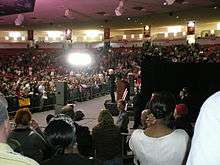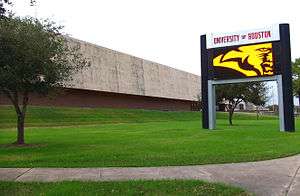Hofheinz Pavilion
| The Hof | |
|
| |
|
The exterior of Hofheinz Pavilion on Cullen Boulevard | |
| Full name | Hofheinz Pavilion |
|---|---|
| Location |
3875 Holman Street Houston, Texas 77004 |
| Coordinates | 29°43′29″N 95°20′49″W / 29.72472°N 95.34694°WCoordinates: 29°43′29″N 95°20′49″W / 29.72472°N 95.34694°W |
| Owner | University of Houston System |
| Operator | University of Houston |
| Capacity |
10,000 (1969–1998) 8,479 (1998–present) |
| Record attendance |
10,660 8,918 (with present capacity) |
| Construction | |
| Broke ground | 1967 |
| Opened | December 1, 1969 |
| Renovated | 1991, 1992, 1998, 2004 |
| Construction cost |
$4.2 million[1] ($27.1 million in 2016 dollars[2]) |
| Architect | Lloyd, Morgan & Jones |
| Structural engineer | Walter P Moore[3] |
| General contractor | H. A. Lott, Inc.[4] |
| Tenants | |
|
Houston Cougars (NCAA) (1969–present) Houston Rockets (NBA) (1971–1975) | |
Hofheinz Pavilion is a 8,479-seat multi-purpose arena on the University of Houston campus in Houston, Texas. Located at 3875 Holman Street, it is home to the University of Houston Cougars men's and women's basketball teams as well as the women's volleyball team. The building is named after Judge Roy Hofheinz and was named for the late wife, Irene Cafcalas "Dene" Hofheinz, of Houston politician, businessman and philanthropist Judge Roy Hofheinz, who is a UH alumnus, while the court is named for hall of fame and former Cougars coach Guy V. Lewis. The arena also contains an alcove dedicated to Basketball Hall of Famer Elvin Hayes, a Cougar player in the 1960s and NBA star in the 1970s. The arena opened in 1969. Like many arenas of its kind, the seating bowl of Fertitta Center is dug into the ground so that one enters the building at the top of the bowl. This arena has been renovated several times in recent years.
In June 2010, the University of Houston announced a $40 million plan to renovate Hofheinz Pavilion. Ultimately in November 2015, the Board of Regents approved a $60M complete re-design of the facility to open in 2018, funded in part by a $20 million naming rights gift. The arena changed its name from Hofheinz Pavilion. The school and the Hofheinz family reached a settlement to honor Judge Hofheinz by building a plaza containing a bronze statue of him near the new facility. In addition, the UH library will archive Judge Hofheinz's historical records in a special section. Finally, UH will petition the city of Houston to change the name of Holman Street between Cullen Boulevard and Scott Street to honor the Hofheinz family name.[5]
The NBA's Houston Rockets used the arena as their first home in Houston. In addition to athletics, the arena has been used for other purposes such as UH graduation ceremonies and area high school commencements. It has also hosted many concerts by famous artists. The Summit took over for much of these purposes in the city after its construction in 1975.
History

Prior to 1969, the basketball team of the University of Houston hosted their home games at high school arenas such as Jeppesen Gym and Delmar Field House.[6] Hofheinz Pavilion was meant to replace these venues as a permanent location.
The first athletic event at Hofheinz Pavilion was held on December 1, 1969 when the Houston Cougars men's basketball team defeated Southwestern Louisiana 89–72 before a crowd of 7,000.[7]
When the team relocated from San Diego in 1971, the NBA's Houston Rockets used the venue as their home arena, although selected games were played at the Astrodome. The Rockets played at Hofheinz Pavilion during their first four seasons in Houston until the construction of The Summit was completed in 1975.
On March 5, 1990, Hofheinz Pavilion hosted its largest amount of spectators to date when a 10,660 crowd attended a men's basketball game where Houston beat Texas.[8]
A new ceiling, lighting and sound system were installed in 1991. Through a donation by alumni John and Rebecca Moores in 1992, the basketball locker rooms were enlarged and equipped with personal lockers for each player. Also added was a meeting area and lounge furnished with couches, a color television, a stereo sound system and a pull-down projection screen.
In 1995, the arena was renamed to "Guy V. Lewis Court at Hofheinz Pavilion" in honor of College Basketball Hall of Fame coach Guy V. Lewis.[9]
In 1998, Hofheinz Pavilion again underwent a renovation as part of a capital improvement campaign undertaken by the university to upgrade its athletic facilities. In its original format Hofheinz Pavilion had a seating capacity of 10,000. As part of the renovation, a ring of luxury suites was added to the top of the seating bowl. This addition necessitated the removal of 1,500 seats, reducing capacity to its current level of 8,479. The new Connor Uni-Force Flooring System was installed in October 2004. In June 2010, the University of Houston announced its intention to undergo a $40 million renovation and expansion to Fertitta Center after a four-month feasibility study conducted by AECOM.[10] This would mark the largest single financial investment to the arena yet.
Concerts

Hofheinz Pavilion has hosted George Harrison, Elton John, Jethro Tull, The Clash, Procol Harum, Elvis Presley, Emerson Lake & Palmer, Frank Zappa, Grateful Dead, Led Zeppelin, The Who, The Rolling Stones, The Jackson 5, Alice Cooper, Bob Dylan, The Band, Prince & The New Power Generation, Madonna, Genesis, and Yes.[11]
Prince held several shows at Hofheinz Pavilion on his Musicology Tour in 2004. Popular music concerts are still held at Hofheinz Pavilion, often when a major act decides against playing at the larger (and ticketing-industry controlled) venues in town. Among the recent examples have been concerts by more recent acts like P!nk, Taylor Swift (both in 2009), Chris Brown, Katy Perry (both in 2011), Eric Church (in 2012), Muse and the Zac Brown Band (both in 2013). Houston native David Cook played at Hofheinz Pavilion as part of the 2008 edition of the American Idols Live! Tour. In 2014, A live concert The Grateful Dead played there on November 18, 1972 was released on compact disc and limited edition vinyl.
See also
References
- ↑ "Centers of Attention". Texas Comptroller. November 1995. Retrieved January 8, 2008.
- ↑ Federal Reserve Bank of Minneapolis Community Development Project. "Consumer Price Index (estimate) 1800–". Federal Reserve Bank of Minneapolis. Retrieved October 21, 2016.
- ↑ "Arenas". Walter P Moore. Archived from the original on July 8, 2000. Retrieved November 10, 2013.
- ↑ Markley, Melanie (February 18, 2004). "Deaths: Al Jensen, Executive of Firm That Built Dome". Houston Chronicle. Retrieved February 7, 2014.
- ↑ Laymance, Reid (June 14, 2016). "UH, Hofheinz family agree on plan for naming new basketball arena". Houston Chronicle. Retrieved June 16, 2016.
- ↑ "Houston's No. 1, But Not at Home". Pittsburgh Press. January 31, 1968. Retrieved June 13, 2010.
- ↑ "Hofheinz Pavilion". University of Houston Athletics. Retrieved December 8, 2008.
- ↑ "Hofheinz Pavilion Records" (PDF). University of Houston Athletics. Retrieved December 8, 2008.
- ↑ "History & Tradition" (PDF). University of Houston Athletics. Retrieved December 8, 2008.
- ↑ Campbell, Steve (June 11, 2010). "UH Ups the Sports Ante – by $160 Million". Houston Chronicle. Retrieved June 13, 2010.
- ↑ "Taking Liberty's at Fitzgerald's". Houston Press. July 16, 2007. Retrieved February 2, 2010.
External links
| Wikimedia Commons has media related to Hofheinz Pavilion. |

